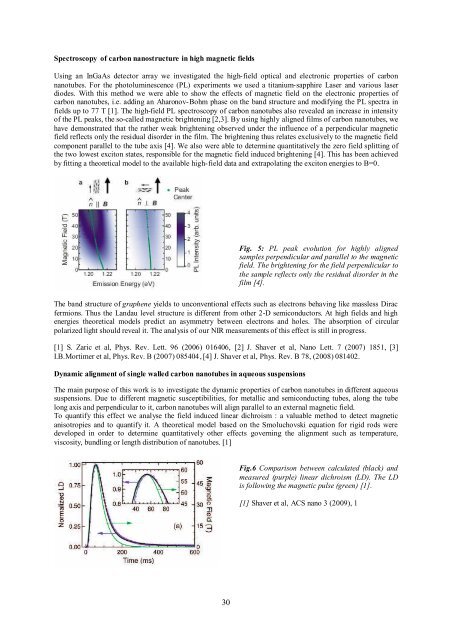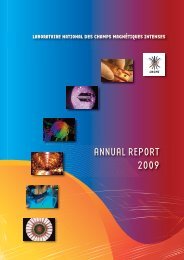Laboratoire National des Champs Magnétiques Pulsés CNRS – INSA
Laboratoire National des Champs Magnétiques Pulsés CNRS – INSA
Laboratoire National des Champs Magnétiques Pulsés CNRS – INSA
Create successful ePaper yourself
Turn your PDF publications into a flip-book with our unique Google optimized e-Paper software.
Spectroscopy of carbon nanostructure in high magnetic fields<br />
Using an InGaAs detector array we investigated the high-field optical and electronic properties of carbon<br />
nanotubes. For the photoluminescence (PL) experiments we used a titanium-sapphire Laser and various laser<br />
dio<strong>des</strong>. With this method we were able to show the effects of magnetic field on the electronic properties of<br />
carbon nanotubes, i.e. adding an Aharonov-Bohm phase on the band structure and modifying the PL spectra in<br />
fields up to 77 T [1]. The high-field PL spectroscopy of carbon nanotubes also revealed an increase in intensity<br />
of the PL peaks, the so-called magnetic brightening [2,3]. By using highly aligned films of carbon nanotubes, we<br />
have demonstrated that the rather weak brightening observed under the influence of a perpendicular magnetic<br />
field reflects only the residual disorder in the film. The brightening thus relates exclusively to the magnetic field<br />
component parallel to the tube axis [4]. We also were able to determine quantitatively the zero field splitting of<br />
the two lowest exciton states, responsible for the magnetic field induced brightening [4]. This has been achieved<br />
by fitting a theoretical model to the available high-field data and extrapolating the exciton energies to B=0.<br />
30<br />
Fig. 5: PL peak evolution for highly aligned<br />
samples perpendicular and parallel to the magnetic<br />
field. The brightening for the field perpendicular to<br />
the sample reflects only the residual disorder in the<br />
film [4].<br />
The band structure of graphene yields to unconventional effects such as electrons behaving like massless Dirac<br />
fermions. Thus the Landau level structure is different from other 2-D semiconductors. At high fields and high<br />
energies theoretical models predict an asymmetry between electrons and holes. The absorption of circular<br />
polarized light should reveal it. The analysis of our NIR measurements of this effect is still in progress.<br />
[1] S. Zaric et al, Phys. Rev. Lett. 96 (2006) 016406, [2] J. Shaver et al, Nano Lett. 7 (2007) 1851, [3]<br />
I.B.Mortimer et al, Phys. Rev. B (2007) 085404, [4] J. Shaver et al, Phys. Rev. B 78, (2008) 081402.<br />
Dynamic alignment of single walled carbon nanotubes in aqueous suspensions<br />
The main purpose of this work is to investigate the dynamic properties of carbon nanotubes in different aqueous<br />
suspensions. Due to different magnetic susceptibilities, for metallic and semiconducting tubes, along the tube<br />
long axis and perpendicular to it, carbon nanotubes will align parallel to an external magnetic field.<br />
To quantify this effect we analyse the field induced linear dichroism : a valuable method to detect magnetic<br />
anisotropies and to quantify it. A theoretical model based on the Smoluchovski equation for rigid rods were<br />
developed in order to determine quantitatively other effects governing the alignment such as temperature,<br />
viscosity, bundling or length distribution of nanotubes. [1]<br />
Fig.6 Comparison between calculated (black) and<br />
measured (purple) linear dichroism (LD). The LD<br />
is following the magnetic pulse (green) [1].<br />
[1] Shaver et al, ACS nano 3 (2009), 1







